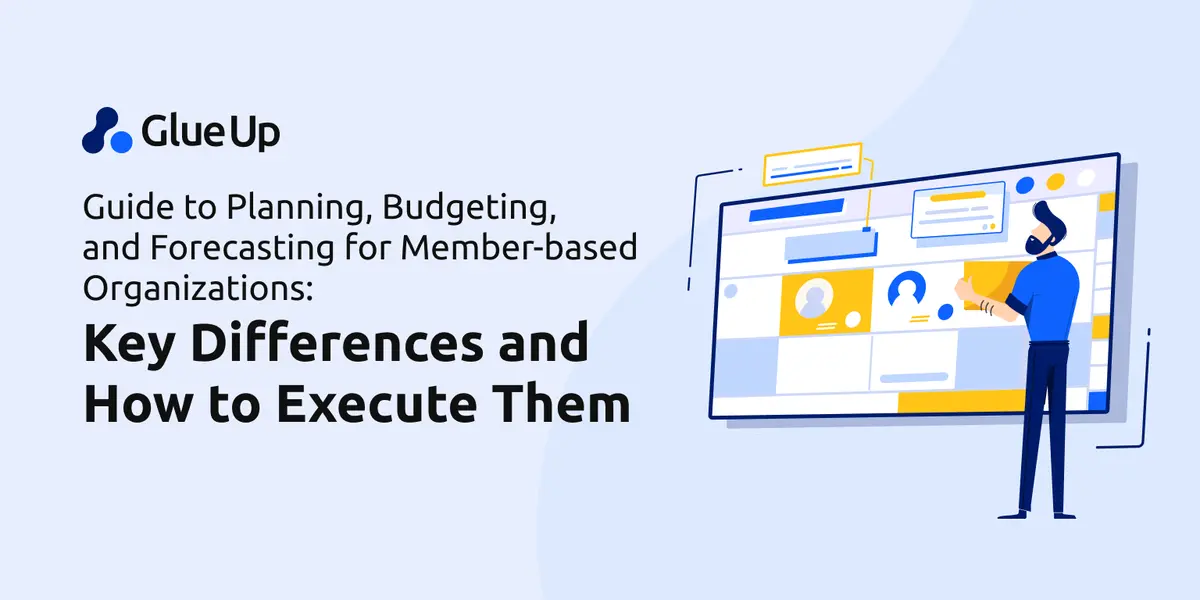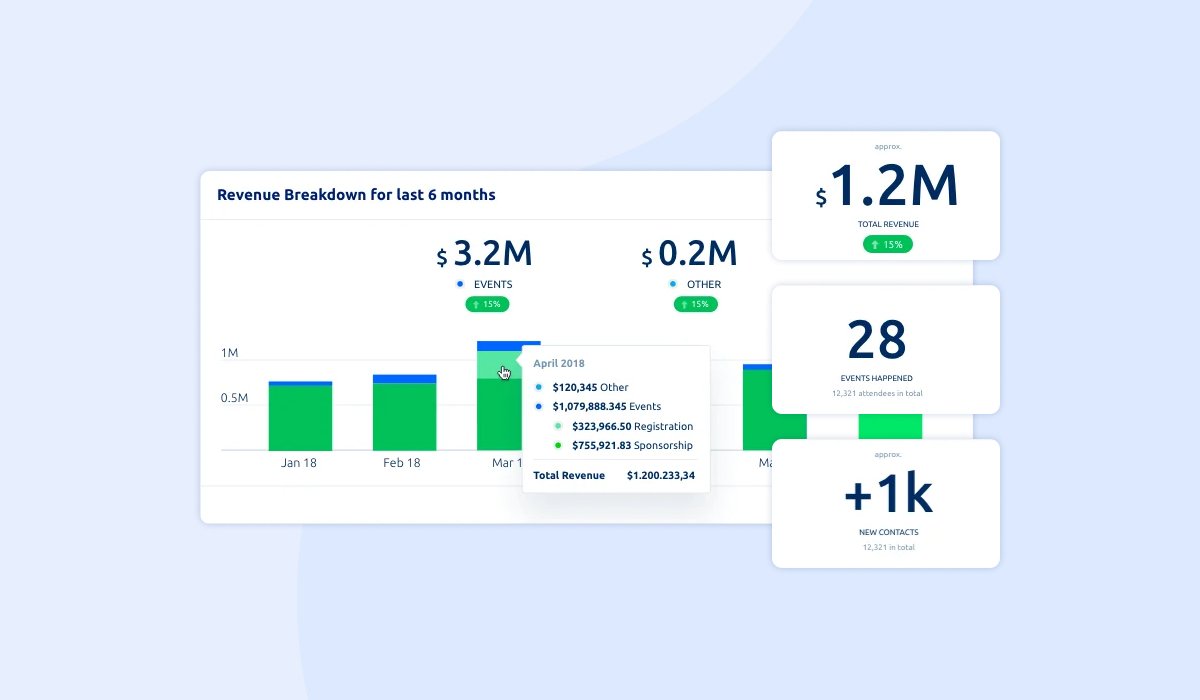
A well-thought-out fiscal plan is crucial for successful organizations. This is especially true when it comes to developing budgets and forecasts. You need to draft a solid financial forecast and set a realistic budget to achieve your objectives for the first quarter and beyond.
In this article, we will provide some actionable steps you can follow to create a budget and forecast for 2025. We will highlight the key differences between planning, budgeting, and forecasting, and offer insights on how to effectively carry them out within your organization as we look ahead to 2025.
Key Takeaways
- Planning, budgeting, and forecasting are critical processes for member-based organizations to allocate resources and achieve goals.
- Effective PBF requires defined activities, timelines, and measurable metrics tied to the organization's mission.
- Major components are expected revenue, expenses, and key performance indicators.
- Forecasting using historical data and current market conditions is crucial for setting realistic revenue and expense expectations.
- Implementing monitoring systems and engaging stakeholders in the budgeting process fosters collaboration and ensures financial control.
- Investing in specialized PBF software can streamline the financial planning process and provide valuable insights for better decision-making.
What is Planning, Budgeting, and Forecasting for Member-based Organizations?

As a leader of an organization, you're likely familiar with the terms planning, budgeting, and forecasting. These interconnected processes are the backbone of resource allocation, goal setting, and performance measurement.
When you engage in planning, you're setting the strategic priorities and initiatives for your organization over a specific time period, typically spanning 3-5 years. This process involves setting clear goals and objectives that will guide your programs and activities.
Budgeting, on the other hand, is about determining the financial resources and expenses required to bring your strategic plan to life. It's about assigning monetary value to specific programs and operations, all in line with your organizational goals.
Forecasting, the third pillar, involves estimating your organization's future revenues and expenses. This process is crucial for accurate budgeting and for keeping a pulse on the health of your organization.
Aligning all three of them is essential for maximizing resources and ensuring your organization achieves its goals.
Understanding the Key Differences Between Planning, Budgeting, and Forecasting
| Planning | Budgeting | Forecasting | |
|---|---|---|---|
| Purpose | Set strategic priorities and long-term goals | Allocate financial resources to execute the strategic plan | Predict future financial conditions based on past and present data |
| Time Horizon | Long-term (3-5 years) | Short-term (Annually or Quarterly) | Ongoing, regularly updated |
| Focus | Strategic objectives and initiatives | Financial allocation to programs and operations | Estimation of revenues and expenses |
| Basis | Organizational mission and market analysis | Organizational goals set in the planning phase | Historical financial data and trends |
| Outcome | Strategic plan with defined goals | Detailed budget with financial allocations | Financial forecasts to aid budgeting and strategic adjustments |
| Interaction | Drives the budget by identifying needs | Translates strategic goals into financial terms | Informs budget adjustments and validates the strategic plan |
While planning, budgeting, and forecasting are interconnected, each serves a unique purpose in your organization:
- Planning is your strategic, long-term roadmap, setting the course for the next 3-5 years.
- Budgeting is more tactical and short-term, focusing on the allocation of funds on an annual or quarterly basis.
- Forecasting predicts future revenues and expenses based on past trends, helping you to budget accurately.
Planning is the driving force behind your budget, linking organizational goals to funding needs. Forecasting, in turn, informs your budget by providing estimates of upcoming costs and income.
While planning sets the stage with broad goals, budgeting, and forecasting bring these goals down to earth, translating them into measurable activities and metrics.
An effective planning, budgeting, and forecasting process ties all three elements together, enabling you to allocate resources efficiently and effectively.
Different Models and Types of Membership Budgets

Your organization will utilize a range of budget types.
Depending on the nature and plans of your organization, you may want to develop budgets that target specific aspects of your organization to ensure comprehensive financial management.
Here are some types of budgets you might consider:
| Capital Expenditure Budget | Program-Specific Budget | Grant Proposal Budget | |
|---|---|---|---|
| Purpose | Forecast expenses and income for long-term projects | Budget for a new project or program | Detail allocation of grant funds |
| Time Horizon | Multi-year | Typically short to medium-term term depending on the program duration | As per the grant proposal terms |
| Focus | Long-term assets and significant expenditure initiatives | Specific revenue and expenses for program initiation and maintenance | Effective allocation of grant resources to meet organizational goals |
| Nature | Strategic financial plan | Detailed operational budget | Financial blueprint for potential funders |
| Outcome | Investment plan in long-term assets | Financial plan for program launch and ongoing operations | Budget proposal to secure grant funding |
| Integration with other budgets | Often integrated into the organizational master budget | May be integrated into the operating budget post-program launch | May influence or be influenced by organizational and program-specific budgets |
Capital Expenditure Budget
This type of budget is designed to forecast the expenses and income related to long-term, multi-year projects. It is typically used to manage your capital campaigns and other significant expenditure initiatives.
The capital budget is not just a projection, but a strategic financial plan that guides your organization's investment in long-term assets.
Program-Specific Budget
When your organization is on the verge of initiating a new project or program, a distinct budget is often created. This budget outlines the specific revenue required and the anticipated expenses that will be incurred during the program's launch.
It's crucial to account for both the one-time costs associated with the program's initiation and the recurring expenses that will need to be integrated into your operating budget for its ongoing maintenance.
Grant Proposal Budget
In the process of applying for a grant, it's often necessary to formulate a budget that details how the grant funds will be utilized to further your organization's mission.
It serves as a financial blueprint, demonstrating to potential funders how their resources will be allocated effectively.
Each of these budget types serves a distinct purpose, whether it's strategizing for long-term asset investments, managing the financial aspects of a new program, or planning the financial allocation of grant funds.
Choose the type(s) that align with your organization's goals and ensure effective financial planning.
Steps for Planning, Budgeting, and Forecasting for 2025
Step 1: Understanding the Strategic Plan
Begin by understanding the strategic plan of your organization. This involves reviewing the mission statement, values, short and long-term goals, and long-term strategies.
For example:
- You may set a 3-year strategic goal to increase membership by 15% and expand member services.
- Your specific objective could be to target young professionals for recruitment through social media campaigns and partner with local colleges to offer student memberships.
- Your strategy could include introducing new member services like initiating a mentorship program to pair experienced members with new members.
Thus, a thorough understanding of the organization's strategic priorities guides budgeting and ensures appropriate resource allocation.
Step 2: Budget Allocation
Once you've understood your strategic plan, your next move is to allocate budgets that support your key objectives and new initiatives.
For instance, you might set aside:
- $50,000 for marketing and outreach to recruit young professionals, using digital ads and events.
- Additional $75,000 to establish and manage a new mentorship program, covering technology, training, events, and coordination costs.
You need to pay equal attention to income and expenses if you have multiple revenue streams for your organization.
Thus, the two primary elements of your budget are projected income and expenses. Let's examine each in more detail.
Projected Income
Your projected income should be divided and assigned according to each source of income. Utilize historical data from your development team to better anticipate and estimate the amount you'll generate from each source.
This should include your fundraising income, grant funds, membership income, in-kind donations, corporate sponsorships, and other revenues.
To forecast your organization's future income, you can employ two methods. Both of these methods provide some budgetary flexibility, increasing the likelihood of your organization staying on track throughout the year.
Discount method
In this approach, your team determines the expected amount from each income source and then multiplies that amount by the income probability percentage.
For instance, if you're applying for a $20,000 grant with an 85% chance of success, you'd adjust the projected income to $17,000.
Cutoff method
In this approach, your team calculates the total anticipated income and then multiplies this figure by your overall probability estimate.
If you had a successful fundraising track record and anticipated a 70% success rate for your predicted $100,000 income, you would project $70,000.
Regardless of the method you select, it's important to remember that it's risky to assume a 100% success rate for all your expected income.
The best approach here is to be conservative in your planning to ensure you have sufficient funds to achieve your goals, even in the event of unforeseen circumstances.
Project Expenses
The second component of an effective budget is your expenses. You’ll use this area to determine and predict the costs your organization will incur when funding your various projects, programs, and campaigns.
Expenses are usually broken down into fundraising, administrative, and program categories. The combination of your fundraising and administrative expenses makes up your organization's overhead.
While every organizational expense budget will look slightly different, the Better Business Bureau recommends that organizations don’t spend more than 35% of their funding on their overhead expenses and spend at least 65% on their programs.
As we mentioned before, your expenses will fall under the following categories:
- Fundraising expenses can be categorized by campaign marketing costs, fundraising event venue or virtual software investments, and fundraising technology costs.
- Administrative expenses can be broken down into things like employee compensation, the investments you make to organize data, the rent for your office space, and the bills you pay for your organization.
- Program expenses are those that are necessary to conduct your work in the community. For instance, an organization that encourages music education for underprivileged kids might invest in classroom space, instruments, and music books for their program.
The best way to estimate what your expenses will be is by examining what you’ve spent in the past and by collecting quotes for new expenses. Consider which of these recurring expenses are fixed and which ones are variable.
Fixed expenses are those that are constant from year to year, like your organization’s office rent. You can count on this to be the same price from year to year due to the contract you have with your management company.
Meanwhile, variable expenses are those that change from year to year. For example, your fundraising expenses might vary depending on the campaigns you’re running.
Step 3: Forecasting Revenue and Expenses
The third step involves accurately forecasting revenues and expenses, a critical aspect of developing a realistic and meaningful budget.
Your revenue projections should draw on historical data, while also considering the potential impact of new strategic initiatives.
For instance, you might forecast a 10% increase in membership dues revenue over the previous year, totaling $1.5 million. On the expense side, costs for both existing and new programs need to be meticulously estimated by finance leaders and department heads.
This careful planning aligns budget allocations with the resources truly needed for execution. However, you will have to monitor your results versus forecasts to identify where adjustments may be needed.
Step 4: Defining and Measuring Key Performance Indicators (KPIs)

Defining clear, measurable metrics is important when creating the budget for next year. Associate each budget line item or activity with specific dollar amounts for expenses and revenue sources.
Break down expected revenue by source - for example, if expecting $100,000 total from individual fundraising, determine how much will come from major donors, peer-to-peer campaigns, online donations, direct mail, etc.
Make sure revenue goals are realistic based on past performance, but also aspirational to motivate your team. Find the right balance between stretch goals and achievable targets.
Analyzing past data and categorizing all budget activities with defined metrics will lead to a well-developed, meaningful budget.
Step 5. Establishing Monitoring Systems
Implement monitoring systems to compare budgeted figures with actual performance. This involves setting up processes to regularly compare your actual spending and performance data against the figures outlined in your budget.
You should review these budgets versus actual reports on a monthly, quarterly, and annual basis. Any significant variances or deviations from the budget should be investigated and addressed in a timely manner.
For example, if a particular department is forecasted to exceed its budget allocation by a wide margin, you can work with that group to understand the drivers behind the overage and make adjustments to bring spending back in line.
Step 6. Stakeholder Engagement
Budgeting should not be an isolated process. It's important to involve key stakeholders across your organization, including staff, board members, donors, and program managers.
They may have valuable insights into the resource needs and costs associated with their specific programs or operational areas. By leveraging their expertise, you can create a more accurate and reasonable budget, fostering organizational alignment around shared financial goals and priorities.
Step 7: Scenario Planning
Prepare for unexpected shifts in your financial landscape by incorporating multiple scenarios into your budget and forecast. This process involves considering various factors such as economic growth, customer demand, production costs, competitive dynamics, and regulatory changes.
The aim is to stress-test your financial plan under different plausible scenarios, providing a comprehensive understanding of potential risks and opportunities. This knowledge enables the proactive development of contingency plans, enhancing strategic agility and ensuring your budgets account for a reasonable range of situations your business may encounter.
8. Leveraging Technology for Efficient PBF Processes
Technology plays a crucial role in streamlining planning, budgeting, and forecasting processes for member-based organizations. Embracing digital tools can significantly enhance accuracy, collaboration, and real-time insights.
Cloud-based platforms allow teams to work simultaneously on budgets and forecasts, ensuring everyone has access to the most up-to-date information. Advanced analytics and machine learning algorithms can help identify trends and patterns in historical data, leading to more accurate forecasts.
Additionally, the automation of routine tasks frees up time for strategic analysis and decision-making. By integrating technology into your PBF processes, you can improve efficiency, reduce errors, and gain a competitive edge in managing your organization's finances.
9. Evaluating and Implementing PBF Software
Investing in Planning, Budgeting, and Forecasting (PBF) software can significantly streamline your financial planning process.
When evaluating software options, consider specific factors such as ease of use, scalability, and integration. Here are some options for you to consider:
AnaPlan
AnaPlan is a robust PBF software that offers a comprehensive suite of financial planning tools. It is known for its user-friendly interface and powerful modeling capabilities.
The software is highly scalable, making it suitable for both small businesses and large corporations. AnaPlan also integrates seamlessly with various ERP systems, enhancing its functionality and ease of use.
Glue Up

Glue Up is a versatile software solution that combines event management, membership management, and CRM capabilities.
While not a traditional PBF software, it offers budgeting and financial planning features that can be beneficial for organizations, especially nonprofits. Its unique selling point is its ability to manage and track funds, making it a good choice for organizations that rely heavily on fundraising.
Causal
Causal is a PBF software that stands out for its intuitive and visually appealing interface. It allows users to create interactive, easy-to-understand financial models without requiring extensive technical knowledge.
The software is particularly useful for startups and small businesses due to its simplicity and affordability. It also offers integration with other financial tools, enhancing its utility.
Jirav
Jirav is another comprehensive financial planning and analysis software that combines budgeting, forecasting, reporting, and analytics in one platform. It is designed to help businesses streamline their financial processes and make data-driven decisions.
Jirav is known for its detailed financial modeling capabilities and its ability to integrate with various accounting systems.
Datarails
Datarails is a financial analysis platform that focuses on automating and enhancing Excel-based financial planning. It offers a solution for businesses that rely heavily on Excel for their financial processes but want to improve accuracy, efficiency, and collaboration.
The software provides an Excel-like interface, making it easy for users to adapt, and it integrates with various financial systems for seamless data import and export.
10. Continuous Review and Adjustment

Establish a routine review process to track progress toward your budget and strategic goals.
It's advised by many professionals to assess your budget on an annual, quarterly, and monthly basis to ensure your organization is following the right financial path.
- The yearly assessment of your budget typically takes place when you're drafting the budget for the upcoming year. You, along with your team, will analyze the financial projections from the previous year, identifying where the budget adhered to the plan and where it deviated. This analysis will guide your forecast of income and expenses for the next fiscal year.
- During your team's quarterly budget meetings, you should compare the projected income and expenses for that quarter with the actual figures. It's also important to evaluate your grant budgets, identifying which funds were secured, utilized, remained unused, and so forth. Lastly, scrutinize the entire budget for any inconsistencies. Identifying these early and documenting them will be beneficial for future budget planning.
- Monthly budget evaluations provide an opportunity for your team to regularly convene and scrutinize the month's finances, comparing the projected versus actual expenses and income for individual projects. Additionally, you can examine balance sheets for any inconsistencies and anticipate future budget items to ensure they seem to be on track.
Also, it’s important to cultivate a culture of continuous improvement, organizational learning, and adaptability to ensure long-term success. Make sure to keep your budgeting process dynamic, responsive, and adaptable to evolving internal and external circumstances.
Free Planning, Budgeting, and Forecasting Template for Member-based Organizations
It's advisable to consult with a skilled accountant for your annual budget planning. Such a professional can guide you toward identifying areas where you can reduce costs and enhance fundraising income.
You can also attempt to formulate your organization's budget using appropriate templates and resources. Here is a complimentary budgeting template from Glue Up that you can utilize as a starting point.
Click here to download
Are you targeting a more streamlined financial process, along with enhanced workflows within your organization? Engage with us and discover how Glue Up can be your catalyst for organizational success.
With Glue Up, not only can you automate and simplify complex financial processes, but also unlock new efficiencies across various operational spheres. Our platform is designed to foster collaboration, ensure compliance, and provide insightful analytics that drive informed decision-making.
By harnessing the power of Glue Up, you're not just managing your finances better; you're setting a solid foundation for sustainable growth and a future replete with achievements. Reach out today, and let’s embark on this transformative journey together.
FAQs
1. What are the elements of a membership budget?
A membership budget primarily consists of dues revenue, which is the income generated from member subscriptions. This is a crucial part of the budget as it forms the backbone of the organization's financial health.
Expenses for member services and recruitment are also key elements that include costs associated with hosting events, providing member benefits, and marketing efforts to attract new members.
Overhead costs, such as staff salaries and technology infrastructure, are also integral elements to consider. However, the specific structure of the budget can vary depending on the type of membership model your organization follows.
2. When should we make our annual budget?
The annual budgeting process should ideally kick off 2-4 months before the start of the fiscal year. This timeline allows for a comprehensive approach, providing ample time for stakeholder input, necessary revisions, and board approval. It's a democratic and inclusive process that ensures the budget aligns with the organization's goals and member needs.
3. How often should we re-forecast during the year?
It's advisable to revisit revenue and expense forecasts either quarterly or mid-year. This practice allows the organization to stay agile, adjusting the budget based on updated projections and ensuring it remains a useful tool for financial management.
4. What PBF skills should our team develop?
The team involved in this process should possess key performance-based budgeting skills. These include financial analysis for informed decision-making, data-driven forecasting for accurate future predictions, budget monitoring to ensure spending stays within limits, and the ability to align resources with strategic goals.
5. Who should be involved in membership organization budgeting?
The budgeting process should be a collaborative effort involving a wide range of stakeholders. Staff, board members, volunteers, and member representatives each bring unique insights and perspectives. Their involvement not only ensures a well-rounded budget but also builds buy-in, fostering a sense of ownership and commitment to the organization's financial health.



